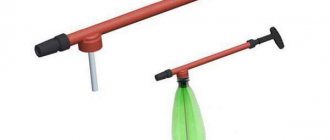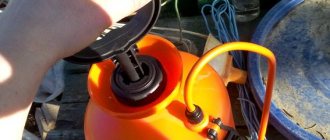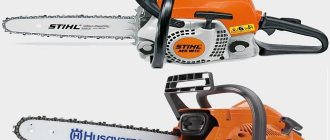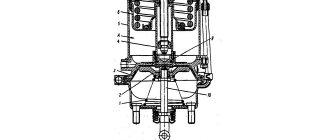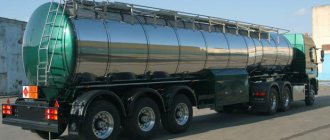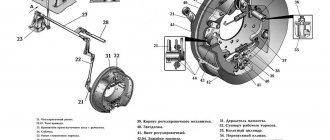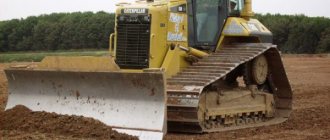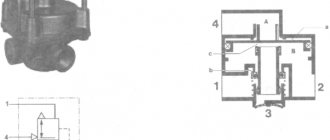The future harvest fully depends on how timely and efficiently the special means for treating garden crops and trees are used.
In this regard, every gardener on the farm should have a manual pump sprayer. This is a practical tool that helps to perform high-quality crop processing or fertilizing, acting efficiently and accurately.
Feature of the tool
Until recently, a simple broom soaked in special chemicals was used to treat plants and trees in the garden. It’s hard to call this method practical, effective and convenient.
In addition, the use of a broom often led to poisoning of the gardeners themselves.
Today, almost every gardener has a special tool with which the process of processing garden crops becomes much easier, more convenient and more effective. This is a sprayer.
Modern manufacturers offer a wide selection of sprayers, each of which has design features, advantages and disadvantages.
The most popular among the different types is the manual pump sprayer.
Regardless of the type of sprayer, its design remains standard. It consists of the following elements:
- Container for liquid. It is presented in the form of a vessel that can have any shape, for example, cylindrical or conical. Plastic or rubber pipes are built into the container. A feature of some models is that the tank may have small legs. As for the capacity of the container, it may vary depending on the model of the sprayer. This figure can vary between 5-12 liters.
- Pen. Its shape influences the convenience and practicality of working with the tool. Some manufacturers use special rubberized linings on the handles.
- Pump. Almost all sprayer models are equipped with pneumatic pumps.
- Valve. This element is designed to bleed off excess air. This prevents the container from bursting.
- Barbells. They can be standard or sliding, flat or curved. Of no small importance is the material that is used to make the barbell. It can be either plastic or metal. The most practical is a metal rod.
- Extension. Its presence makes it possible to increase the length of the rod several times. Thanks to this, the sprayers can be used to treat tall trees.
- Nozzle. Used to adjust the jet type and its power.
- Filter. Capable of extending the life of the device by retaining particles of large or medium fractions that may be present in the liquid.
- Nozzles The kit includes several replacement nozzles for the pump sprayer. This increases the functionality and practicality of using the equipment. The use of nozzles allows you to change the pressure and force of the liquid jet. As a result of raising and lowering the pump handle, air is pumped, which subsequently pushes the liquid through the rod.
- Fastening. Their main purpose is to facilitate the process of assembling and disassembling the sprayer, as well as to ensure high-quality tightness of connections.
The quality of each of the above elements affects the efficiency of use of the sprayer, as well as its service life.
Advantages and disadvantages
Each device has a number of disadvantages and positive aspects.
Pump sprayers have the disadvantage of constantly removing the device from the back to pump up pressure, while other models have the disadvantage of refueling.
Pros of sprayers:
- devices are made of materials that can withstand high temperatures, which allows the use of hot preparations;
- ease of the refueling process;
- adjusting the liquid ejection jet;
- ease of carrying and using equipment;
- ease of repair;
- use in areas of various sizes;
- efficiency and functionality of the devices.
Operating principle of the equipment
The popularity of manual garden pump sprayers among gardeners and gardeners is explained primarily by the simplicity of their design and the principle of their operation.
Briefly, the operating principle of these devices is as follows:
- Air is pumped into the liquid container until a certain pressure level is reached. This indicator is directly dependent on the device model;
- the operator presses the lever;
- the valve of the device opens;
- air is squeezed out of the nozzle along with the liquid;
- When the pressure level in the tank decreases, the operator needs to re-pump air into the tank.
This operating principle is typical for each device model, regardless of its type.
Range of sprayers
The modern market offers a wide range of sprayers from leading domestic and foreign manufacturers - Tuman, Kuhn, Lemken, Amazone, Berthoud. Among others, it is worth highlighting equipment for applying fertilizers and protective agents for pest control from the German company Lemken, which supplies the market with highly productive and very efficient models.
Sprayer Lemken Albatros
Lemken trailed field sprayers guarantee professional plant protection and optimal watering. The Primus series with a tank from 2400–4000 l demonstrates excellent performance, maneuverability and economical consumption. The Albatros series includes models for efficient crop production, which are customized to the individual needs of the farm.
How to choose the right spray bottle
The practicality and convenience of working with a garden pump sprayer directly depends on how correctly the choice was made. To do this, experts recommend paying attention to the following sprayer criteria:
- The purposes for which the equipment is intended to be used. If you plan to work with small plantings or crops, it is better to opt for sprayers with a small tank volume and a short boom. If the device will be used for spraying trees and tall shrubs, purchasing a unit model with a short boom will not only be inconvenient, but also impractical.
- Comfortable work. To make it convenient to work with the sprayer, it is recommended to give preference to models equipped with a telescopic rod. Thanks to this, it becomes possible to adjust the length of the rod depending on the height of the plantings. In addition, the telescopic rod ensures the range of the device.
- Container for liquid. Most users prefer models whose tank is made of translucent material, such as plastic. Thanks to this, you can visually control the amount of solution in it. Of no small importance is the presence of a measuring scale on the inside of the tank. This also helps to keep control of the amount of liquid remaining in the container and plan work on the site.
- Availability of a filter. This element is of great importance, especially when it comes to pump-action models. The filter helps prevent the possibility of nozzle clogging, extending the life of the device.
- Air valve. Its presence prevents the possibility of rupture of the liquid container in which air accumulates. Using the valve, it is possible to bleed off excess air.
- Possibility of adjusting the nozzle. Thanks to this, the operator can adjust the power of the liquid jet, increasing the practicality of using the device.
- Additional nozzles. It is very important if a set of additional nozzles is sold complete with the sprayer. This increases the functionality of the sprayer.
Taking into account the above criteria when choosing a garden manual pump sprayer, you can purchase a model of the device that will best meet all the requirements of a gardener or gardener.
Kinds
To better understand the essence and purpose of pump-action hand sprayers, it is necessary to compare them with other types.
Firstly, it should be noted that they all differ in the volume of the solution tank. Manual volumes are small. But there are, for example, wheeled ones that can hold a couple of tens of liters of liquid.
If we consider the design itself, then all sprayers can be divided into:
- pump-action;
- lever;
- with an electric motor powered by a battery;
- with an electric motor connected to the network;
- with gasoline engine.
These devices, in turn, differ in the way they move across the sprayed area: there are hand-held, backpack-mounted and wheeled. In this article we will consider only pump-action manual ones.
Possibility of self-production
You can buy a pump sprayer in specialized stores. There is also the opportunity to make the device yourself at home. The advantage of a home-made unit is that it is possible to save money, as well as create just such a model that will fully meet the user’s requirements.
Before starting work, it is recommended to prepare all the necessary materials and tools:
- plastic tank;
- automobile nipple and compressor;
- spray tip;
- hoses.
In order to make a sprayer with your own hands, it is recommended to follow the following sequence of actions:
- Drill holes in the plastic tank.
- Insert the car nipple into them.
- Connect the compressor.
- Seal all openings using special sealant.
You should also pay attention to the use of PVC hoses. This will ensure that the liquid can be sprayed effectively.
The presence of a pump sprayer in the household of every gardener increases the likelihood of getting a good harvest in the future.
Gasoline equivalent - better or worse?
Gasoline-powered sprayers Sprayers
are also available with gasoline power and can be considered as an option.
- Gasoline allows you to install a more powerful pump and make the device more efficient. Thus, while standing still, you can process plants in a larger radius.
- The gasoline drive allows you to use the unit in winter - it can easily blow off snow.
The sprayer is rechargeable - powered by a battery - equipped with a hose and a spray tube of a smaller diameter. A pump of lower power is installed, which significantly narrows the scope of additional economic functions.
The electric device comes with a telescopic tube that increases the range of liquid supply - this partially compensates for the difference in power.
A power sprayer is safer when carried on your back and the overall weight is lighter. Carrying a gas tank on yourself will not create comfortable conditions for gardening for everyone.
The choice remains with the owner of the garden and vegetable garden. It should be borne in mind that the cost of a gasoline unit is much higher - almost three times. A battery sprayer can be bought for 3-4 thousand. For a small garden this is the best option.
Battery model - list of advantages
- Light weight, compact, can be carried on your back.
- Non-volatile - just like gasoline models, it allows you to work in the garden without wires.
- The battery capacity allows you to treat the area without recharging.
- It can be used for indoor cleaning, disinfection, and repair work.
- Nozzles allow you to vary the spray pattern.
- Backpack straps allow you to work in any corner of the garden.
- When the device operates, no emissions are released into the air.
- No need to spend money on oil and fuel.
- The device itself is affordable.
Tips for use
The device comes with instructions for use, which you need to read.
The tips below are based on the experience of people who have been using sprayers for a long time:
- Before starting work, you should inspect the device; if there is damage to the insulation, cracks on the body, work is postponed until it is corrected.
- Before turning on, you must make sure that there is liquid in the tank.
- The battery is designed for 5-7 hours of operation, so after use you need to note how much time is left before charging.
- It is advisable to strain the spray liquid to extend the life of the filters.
- When the temperature is above 450C and in frosty weather, the sprayer should not be used.
- When spraying pesticides, it is recommended to use personal protective equipment.
- The materials of the device are not designed for spraying caustic solutions of acids and alkalis.
- The sprayer should not be used during rain or strong wind.
- The sprayer is stored away from heat sources, in a dry place.
- In winter, you should recharge the battery several times.
